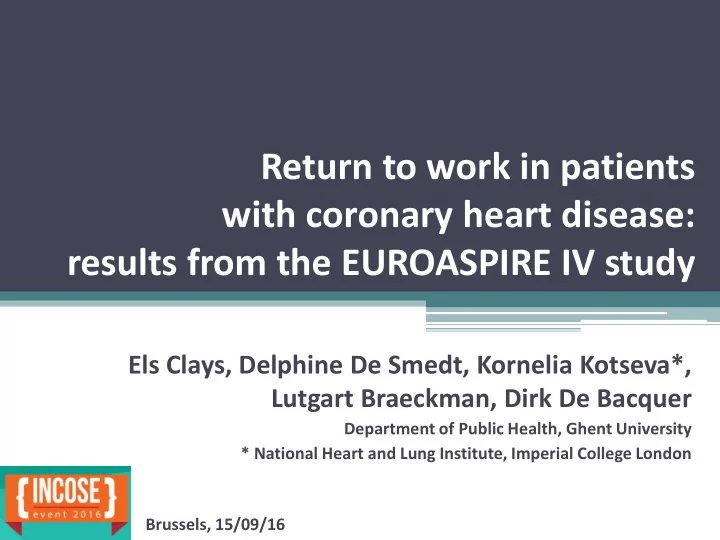

Return to work in patients with coronary heart disease: results from the EUROASPIRE IV study Els Clays, Delphine De Smedt, Kornelia Kotseva*, Lutgart Braeckman, Dirk De Bacquer Department of Public Health, Ghent University * National Heart and Lung Institute, Imperial College London Brussels, 15/09/16
CHD & Sustainable employability Prolonging working life = avoiding premature dropout & long-term sickness absence “ Cardiovascular disorders constitute a major burden for health of working populations throughout the world with as much as 50% of all causes of death and at least 25% of work disability. “ December 2013
CHD & Sustainable employability More insight is needed into the factors associated with return to work in patients with CHD Aim = to investigate return to work in patients with CHD within the EUROASPIRE IV study, and the association with their risk factor profile and health- related quality of life (HRQoL)
EUROASPIRE IV study European Action on Secondary Prevention through Intervention to Reduce Events: 4 th wave in 2012-2013 in 24 countries → N = 7.998 patients 18-80 yr with documented CHD (CABG, PCI, AMI, Ischemia) Data collection in standardized way by trained research staff Baseline information from medical records (retrospective) Interview / clinical examination 6 months to 3 year after event
1994 FIRST JOINT TASK FORCE GUIDELINES EUROASPIRE I 1995-1996 in 9 geographical regions 1998 SECOND JOINT TASK FORCE GUIDELINES EUROASPIRE II 1999-2000 in 15 geographical regions 2003 THIRD JOINT TASK FORCE GUIDELINES EUROASPIRE III 2006-2007 in 22 geographical regions 2007 FOURTH JOINT TASK FORCE GUIDELINES EUROASPIRE IV 2012-2013 in 24 geographical regions 2012 FIFTH JOINT TASK FORCE GUIDELINES EUROASPIRE V 2016-2018 in 26 geographical regions 2016 SIXTH JOINT TASK FORCE GUIDELINES
EUROASPIRE IV countries Ireland Netherlands Finland Russia Germ any UK Latvia Sweden Czech Republic France Poland Lithuania Croatia Belgium Bulgaria Rom ania Spain Slovenia Turkey Greece Serbia Bosnia Cyprus Ukraine Herzegovina
Best imaginable health state Information collected at interview • Personal and demographic information • Medical history • Reported lifestyle changes and risk factor management • Height, weight, waist circumference, blood pressure, cholesterol, plasma glucose, HbA1c → clinical risk factor targets based on European guidelines for cardiovascular prevention • HRQoL : Hospital Anxiety and Depression Scale (HADS), EuroQol Visual Analogue Scale (EQ-VAS) Your own health state today Worst imaginable health state
Return to work in EUROASPIRE IV Not employed before index Mean age 57.8 yr (SD 8.4) event 75% < 63yr 3278 Employed 4668 before index event Missing data 80 70 60 50 40 30 20 10 0 Did not return to Returned to work work after index after index event event
Predictors of return to work* 4 3,5 3 2,5 2 1,5 1 0 ,5 0 younger age male sex medium high OR (per 10 yr) (vs. female) educational educational level level (vs. low) (vs. low) * Results from multiple logistic regression analysis (mutually adjusted)
Predictors of return to work* 1,1 1 0 ,9 0 ,8 0 ,7 0 ,6 0 ,5 0 ,4 diabetes raised Hba1c level in diabetics OR * Results from multiple logistic regression analysis (adjusted for age, sex & education)
Predictors of return to work* 1,1 1 0 ,9 0 ,8 0 ,7 0 ,6 0 ,5 body mass index obesity central obesity OR (per 5 units) * Results from multiple logistic regression analysis (adjusted for age, sex & education)
Predictors of return to work* 2,5 2 1,5 1 0 ,5 0 quit smoking since moderate PA level high PA level (vs. OR event (vs. low) low) * Results from multiple logistic regression analysis (adjusted for age, sex & education)
Predictors of return to work* 2,5 2 1,5 1 0 ,5 0 EQVAS 0-100 HADS: HADS: OR (per 20 units) no depression no anxiety * Results from multiple logistic regression analysis (adjusted for age, sex & education)
NOT related with return to work: Recruiting diagnosis Clinical risk factor targets: raised total / LDL cholesterol raised blood pressure raised glucose in diabetics Cardiac rehabilitation (attending at least ½ of the sessions)
Discussion and Conclusions Limitation: cross-sectional design In general, patients returning to work after a coronary event had a more favorable lifestyle related risk profile, but no associations were found with clinical risk factors → findings suggest that optimal disease management regarding smoking cessation, physical exercise and body weight is beneficial for return to work after CHD Most likely: bidirectional relation between RTW & HRQoL Particular attention should go out to reintegration of patients with diabetes
Thank you! Contact: els.clays@UGent.be
Recommend
More recommend